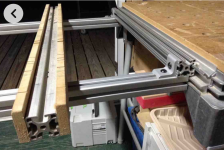squall_line
Member
As the subject suggests...
I ordered a Slab Mill Pro 4 days ago and was given a 10-week shipping estimate. I got an email today with a shipping notice, so now I feel like I'm partially scrambling, as I was planning on having at least a month or two to figure all of this out.
Not that I can't take two months to figure it out, but once I have this in hand, I have so many (50+) slabs that I want to start getting to work on. I think I need to order a bit, too, now that I think of it...
All of my slabs are between 7'6" and 9' long, most right around 8' (I'd have to find my list...). Most are 20-24 inches wide, some are up to 30 at their widest. All either 4/4 or 8/4 white ash or soft maple. Most are live edge, but I have a lot of square-edged ash in the shed.
I have three MFT/3s. I wasn't sure how plausible it would be to connect my MFTs along the short edge to make a 90-ish or 135-ish inch-long work surface, and then attach the rails of the Slab Flattening Mill to the rails of the MFTs, instead of building a plywood frame and/or finding some salvage slab doors as a base for the mill. I know the 30" wide pieces won't work, as they'll hang over the rails.
One MFT lives in the basement and can come up to the garage if absolutely necessary, but it's a horizontal surface in the corner of a basement, so to move it takes deliberate action such as decluttering the thing. It would still be necessary if I didn't shorten some of the slabs before milling.
I don't have the space to store full sheets of plywood very easily, especially not if they also have a torsion frame attached to the base. I have a place to store the mill rails unassembled between pieces as needed, although they aren't exactly short.
Anyone have any suggestions for incorporating MFTs into this workflow? In my head, I have a flat enough garage floor that it shouldn't be too terrible to get everything flat and level with the MFT-to-MFT connectors, but maybe I'm just setting myself up for disappointment and failure?
I have enough slabs that I've already got in mind that at least one or two will end up as my practice pieces while I figure all of this out. It wasn't free wood, but it was pretty cheap all things considered (storm damage that I had milled and kiln-dried).
Any experience or suggestions, even to call me crazy and talk me down a sane path, are welcome!
I ordered a Slab Mill Pro 4 days ago and was given a 10-week shipping estimate. I got an email today with a shipping notice, so now I feel like I'm partially scrambling, as I was planning on having at least a month or two to figure all of this out.
Not that I can't take two months to figure it out, but once I have this in hand, I have so many (50+) slabs that I want to start getting to work on. I think I need to order a bit, too, now that I think of it...
All of my slabs are between 7'6" and 9' long, most right around 8' (I'd have to find my list...). Most are 20-24 inches wide, some are up to 30 at their widest. All either 4/4 or 8/4 white ash or soft maple. Most are live edge, but I have a lot of square-edged ash in the shed.
I have three MFT/3s. I wasn't sure how plausible it would be to connect my MFTs along the short edge to make a 90-ish or 135-ish inch-long work surface, and then attach the rails of the Slab Flattening Mill to the rails of the MFTs, instead of building a plywood frame and/or finding some salvage slab doors as a base for the mill. I know the 30" wide pieces won't work, as they'll hang over the rails.
One MFT lives in the basement and can come up to the garage if absolutely necessary, but it's a horizontal surface in the corner of a basement, so to move it takes deliberate action such as decluttering the thing. It would still be necessary if I didn't shorten some of the slabs before milling.
I don't have the space to store full sheets of plywood very easily, especially not if they also have a torsion frame attached to the base. I have a place to store the mill rails unassembled between pieces as needed, although they aren't exactly short.
Anyone have any suggestions for incorporating MFTs into this workflow? In my head, I have a flat enough garage floor that it shouldn't be too terrible to get everything flat and level with the MFT-to-MFT connectors, but maybe I'm just setting myself up for disappointment and failure?
I have enough slabs that I've already got in mind that at least one or two will end up as my practice pieces while I figure all of this out. It wasn't free wood, but it was pretty cheap all things considered (storm damage that I had milled and kiln-dried).
Any experience or suggestions, even to call me crazy and talk me down a sane path, are welcome!

